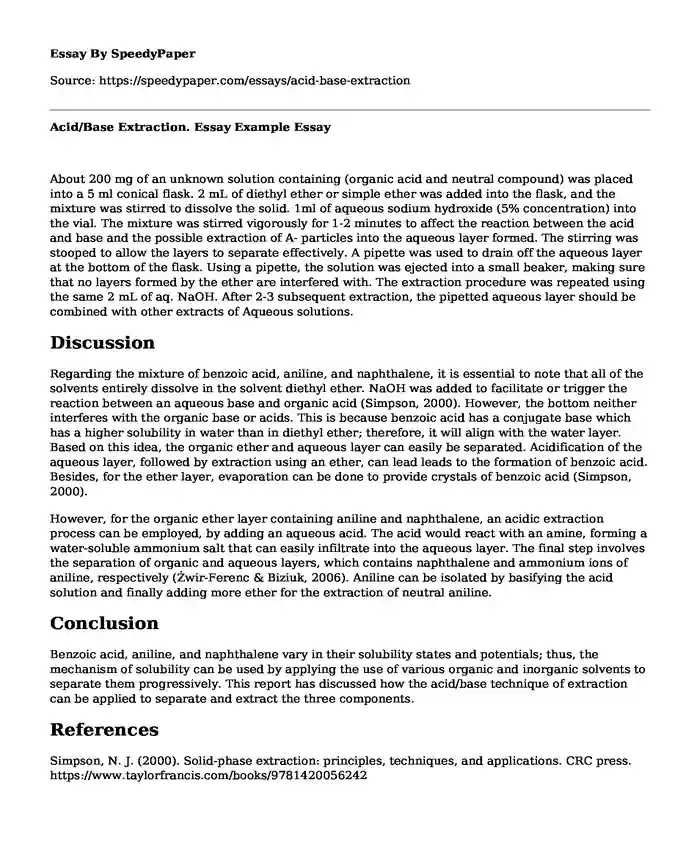
| Essay type: | Process essays |
| Categories: | Knowledge Chemistry Essays by wordcount |
| Pages: | 2 |
| Wordcount: | 489 words |
About 200 mg of an unknown solution containing (organic acid and neutral compound) was placed into a 5 ml conical flask. 2 mL of diethyl ether or simple ether was added into the flask, and the mixture was stirred to dissolve the solid. 1ml of aqueous sodium hydroxide (5% concentration) into the vial. The mixture was stirred vigorously for 1-2 minutes to affect the reaction between the acid and base and the possible extraction of A- particles into the aqueous layer formed. The stirring was stooped to allow the layers to separate effectively. A pipette was used to drain off the aqueous layer at the bottom of the flask. Using a pipette, the solution was ejected into a small beaker, making sure that no layers formed by the ether are interfered with. The extraction procedure was repeated using the same 2 mL of aq. NaOH. After 2-3 subsequent extraction, the pipetted aqueous layer should be combined with other extracts of Aqueous solutions.
Discussion
Regarding the mixture of benzoic acid, aniline, and naphthalene, it is essential to note that all of the solvents entirely dissolve in the solvent diethyl ether. NaOH was added to facilitate or trigger the reaction between an aqueous base and organic acid (Simpson, 2000). However, the bottom neither interferes with the organic base or acids. This is because benzoic acid has a conjugate base which has a higher solubility in water than in diethyl ether; therefore, it will align with the water layer. Based on this idea, the organic ether and aqueous layer can easily be separated. Acidification of the aqueous layer, followed by extraction using an ether, can lead leads to the formation of benzoic acid. Besides, for the ether layer, evaporation can be done to provide crystals of benzoic acid (Simpson, 2000).
However, for the organic ether layer containing aniline and naphthalene, an acidic extraction process can be employed, by adding an aqueous acid. The acid would react with an amine, forming a water-soluble ammonium salt that can easily infiltrate into the aqueous layer. The final step involves the separation of organic and aqueous layers, which contains naphthalene and ammonium ions of aniline, respectively (Zwir-Ferenc & Biziuk, 2006). Aniline can be isolated by basifying the acid solution and finally adding more ether for the extraction of neutral aniline.
Conclusion
Benzoic acid, aniline, and naphthalene vary in their solubility states and potentials; thus, the mechanism of solubility can be used by applying the use of various organic and inorganic solvents to separate them progressively. This report has discussed how the acid/base technique of extraction can be applied to separate and extract the three components.
References
Simpson, N. J. (2000). Solid-phase extraction: principles, techniques, and applications. CRC press. https://www.taylorfrancis.com/books/9781420056242
Zwir-Ferenc, A., & Biziuk, M. (2006). Solid Phase Extraction Technique--Trends, Opportunities, and Applications. Polish Journal of Environmental Studies, 15(5). https://www.researchgate.net/profile/Marek_Biziuk2/publication/279597851_Solid_phase_extraction_technique_-_Trends_opportunities_and_applications/links/5612566b08ae4833751bee10.pdf
Cite this page
Acid/Base Extraction. Essay Example. (2023, Aug 22). Retrieved from https://speedypaper.net/essays/acid-base-extraction
Request Removal
If you are the original author of this essay and no longer wish to have it published on the SpeedyPaper website, please click below to request its removal:
- Free Essay on South Africa Economy
- Essay Sample about Pluto, A Dwarf Planet
- Essay Sample on the Connection between Love and Therapy Culture
- Free Essay on Intelligence: MASINT, OSINT, and HUMINT
- Case Study of the Treatment for Victims of Domestic Violence
- Levittown Essay Example
- Classical and Operant Conditioning Behavioral Theory - Paper Sample
Popular categories




